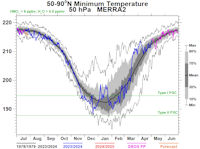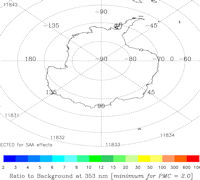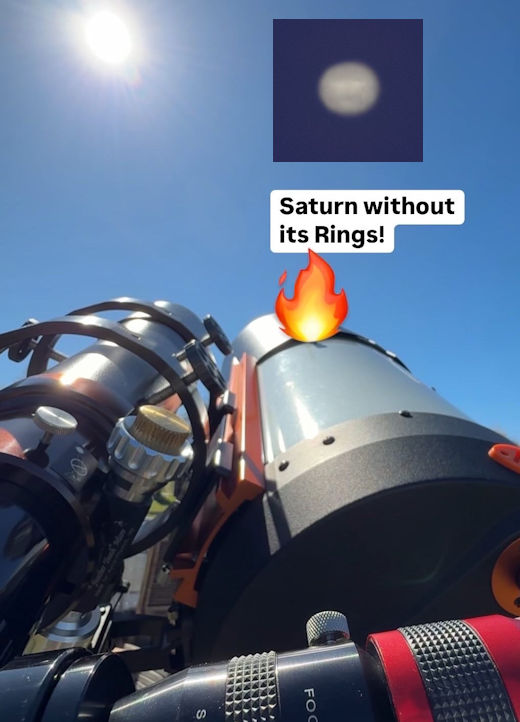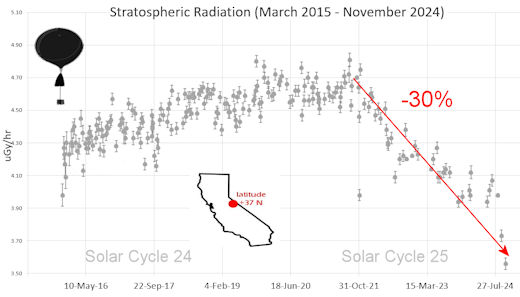 | | | Switch to: Europe, USA, New Zealand, Antarctica Credit: NOAA/Ovation  Planetary K-index Planetary K-index
Now: Kp= 3.67 quiet
24-hr max: Kp= 3.67 quiet
explanation | more data
Interplanetary Mag. Field
Btotal: 8.44 nT
Bz: -0.42 nT south
more data: ACE, DSCOVR
Updated: Today at 1146 UT  Coronal Holes: 12 Apr 25 Coronal Holes: 12 Apr 25 
There are no significant equatorial coronal holes on the Earthside of the sun.. Credit: NASA/SDO | more data  Polar Stratospheric Clouds
Colorful Type II polar stratospheric clouds (PSC) form when the temperature in the stratosphere drops to a staggeringly low -85C. NASA's MERRA-2 climate model predicts when the air up there is cold enough: 
On April 12, 2025, the Arctic stratosphere is much too hot for Type II clouds. | more data. Noctilucent Clouds
The southern season for noctilucent clouds (NLCs) is finished. The first clouds were detected over Antarctica on Nov. 19, 2024, and they vanished again on Feb. 21, 2025. The action will shift to the north pole in late May 2025. Until then, the map will remain blank.

Updated: Feb. 21, 2025
An instrument onboard NOAA 21 (OMPS LP) is able to detect NLCs (also known as "polar mesospheric clouds" or PMCs). In the daily map, above, each dot is a detected cloud. As the season progresses, these dots will multiply in number and shift in hue from blue to red as the brightness of the clouds intensifies.
 SPACE WEATHER
NOAA Forecasts | | Updated at: 2025 Apr 12 2200 UTC FLARE | 0-24 hr | 24-48 hr | CLASS M | 70 % | 70 % | CLASS X | 15 % | 15 % |  Geomagnetic Storms: Geomagnetic Storms:
Probabilities for significant disturbances in Earth's magnetic field are given for three activity levels: active, minor storm, severe storm Updated at: 2025 Apr 12 2200 UTC Mid-latitudes | 0-24 hr | 24-48 hr | ACTIVE | 35 % | 30 % | MINOR | 20 % | 10 % | SEVERE | 05 % | 01 % | High latitudes | 0-24 hr | 24-48 hr | ACTIVE | 10 % | 15 % | MINOR | 30 % | 30 % | SEVERE | 50 % | 40 % | | | |  | | | | | | | | | | | This is an AI Free Zone: Text created by Large Language Models is spreading across the Internet. It's well-written, but frequently inaccurate. If you find a mistake on Spaceweather.com, rest assured it was made by a real human being. | | | WEEKEND AURORA WATCH: NOAA forecasters say that minor G1-class geomagnetic storms are possible today, April 12th , when a CME might graze Earth's magnetic field. The CME was hurled into space by an erupting solar filament on April 8th. High-latitude sky watchers should be alert for auroras mixed with full moonlight. Aurora alerts: SMS Text. WHAT HAPPENED TO SATURN'S RINGS? Saturn is so close to the sun that most astronomers have been missing a big event. The planet's rings have vanished. Sébastien Voltmer captured the phenomenon on April 9th in broad daylight over Spicheren, France: 
"This rare daylight shot of Saturn next to the sun is dangerous for your eyes and gear," says Voltmer. "However, it was a great experience finding the ghostly-looking planet without its rings in the very transparent blue sky." This is called a "ring plane crossing." On March 23, 2025, Earth passed through the plane of Saturn's rings. From our point of view, the vast ring system narrowed to an almost-invisible line. Usually this would make astronomy headlines. However, the ring plane crossing of 2025 occured while Saturn was dangerously close to the sun. Only now in early April is Saturn emerging from the glare so we can see what it looks like as "naked planet." The next ring plane crossing visible in the night sky will be a triple passage in 2038-39: October 15, 2038; April 1, 2039; and July 9, 2039. Mark your calendar. Realtime Space Weather Photo Gallery
Free: Spaceweather.com Newsletter
ROSE GOLD MOONSTONE PENDANT: This moonstone has touched space. On April 9, 2024, the students of Earth to Sky Calculus launched the Rose Gold Moonstone Pendant to the stratosphere onboard a cosmic ray research balloon. For almost two hours it floated 102,800 feet above the Sierra Nevada mountains of Central California: 
You can have it for $172.95. The heart-shaped moonstone is wrapped in a sterling silver frame decorated with 18K rose gold-plated roses. It makes a great anniversary or birthday gift and comes with a greeting card showing the mooonstone in flight. All sales support the student's cosmic ray research program. Far Out Gifts: Earth to Sky Store
All sales support hands-on STEM education
Realtime Aurora Photo Gallery
Free: Spaceweather.com Newsletter
Realtime Comet Photo Gallery
Free: Spaceweather.com Newsletter Every night, a network of NASA all-sky cameras scans the skies above the United States for meteoritic fireballs. Automated software maintained by NASA's Meteoroid Environment Office calculates their orbits, velocity, penetration depth in Earth's atmosphere and many other characteristics. Daily results are presented here on Spaceweather.com. On Apr 11, 2025, the network reported 6 fireballs.
(6 sporadics)  In this diagram of the inner solar system, all of the fireball orbits intersect at a single point--Earth. The orbits are color-coded by velocity, from slow (red) to fast (blue). [Larger image] [movies] Potentially Hazardous Asteroids ( PHAs) are space rocks larger than approximately 100m that can come closer to Earth than 0.05 AU. None of the known PHAs is on a collision course with our planet, although astronomers are finding new ones all the time. On April 12, 2025 there were 2349 potentially hazardous asteroids.
 | Recent & Upcoming Earth-asteroid encounters: | Asteroid | Date(UT) | Miss Distance | Velocity (km/s) | Diameter (m) | | 2025 GW | 2025-Apr-07 | 2.3 LD | 7.6 | 13 | | 2003 GQ22 | 2025-Apr-07 | 19.6 LD | 8.9 | 193 | | 2025 GK1 | 2025-Apr-08 | 16.4 LD | 11.2 | 38 | | 2025 FF18 | 2025-Apr-08 | 8.6 LD | 7.5 | 24 | | 2025 GT | 2025-Apr-08 | 4.6 LD | 13.4 | 15 | | 2025 DL28 | 2025-Apr-08 | 16.2 LD | 5.6 | 41 | | 2025 FN14 | 2025-Apr-08 | 13.6 LD | 7.9 | 39 | | 2025 GX | 2025-Apr-09 | 8 LD | 4 | 15 | | 2025 GA1 | 2025-Apr-09 | 12.5 LD | 5.3 | 15 | | 2025 FX22 | 2025-Apr-10 | 10.1 LD | 12.4 | 21 | | 2023 HG | 2025-Apr-11 | 3.7 LD | 8.6 | 14 | | 2023 KU | 2025-Apr-11 | 2.8 LD | 18 | 119 | | 2015 FS33 | 2025-Apr-12 | 14.6 LD | 20.7 | 107 | | 2025 FP10 | 2025-Apr-12 | 10.8 LD | 14 | 589 | | 2025 GK | 2025-Apr-13 | 17.3 LD | 11.9 | 37 | | 2025 FV13 | 2025-Apr-13 | 18.2 LD | 5 | 29 | | 2023 RX1 | 2025-Apr-13 | 18.1 LD | 1.4 | 3 | | 2023 UH | 2025-Apr-15 | 8.8 LD | 11 | 21 | | 2022 UO | 2025-Apr-15 | 19.8 LD | 16.2 | 18 | | 2025 DC36 | 2025-Apr-15 | 14.2 LD | 4.9 | 61 | | 2011 VG9 | 2025-Apr-16 | 12.2 LD | 23.8 | 124 | | 2025 GV | 2025-Apr-17 | 15.9 LD | 17.4 | 41 | | 2017 RN16 | 2025-Apr-17 | 10.9 LD | 8.7 | 6 | | 2025 FL20 | 2025-Apr-17 | 13.1 LD | 3.4 | 14 | | 2025 GL1 | 2025-Apr-18 | 17.4 LD | 16.3 | 72 | | 2025 FY22 | 2025-Apr-19 | 9.4 LD | 9.2 | 33 | | 2025 FK12 | 2025-Apr-20 | 9.5 LD | 7.3 | 22 | | 2014 HS124 | 2025-Apr-22 | 10.9 LD | 8.9 | 85 | | 2025 GD1 | 2025-Apr-22 | 4.2 LD | 5.9 | 28 | | 2019 FY2 | 2025-Apr-24 | 12.8 LD | 5.3 | 12 | | 462959 | 2025-Apr-25 | 12.9 LD | 9.5 | 217 | | 2024 BF | 2025-May-01 | 9.5 LD | 4.6 | 46 | | 2024 JM2 | 2025-May-03 | 7.2 LD | 11.3 | 62 | | 2021 JN1 | 2025-May-06 | 18.3 LD | 16.3 | 39 | | 2021 HZ | 2025-May-08 | 20 LD | 10.2 | 30 | | 612356 | 2025-May-09 | 11 LD | 5.1 | 305 | | 2021 KH | 2025-May-10 | 18.3 LD | 7.2 | 19 | | 2011 HJ7 | 2025-May-12 | 6.6 LD | 15.8 | 118 | | 2011 YU74 | 2025-May-13 | 11.4 LD | 5 | 90 | | 2025 DT50 | 2025-May-14 | 16 LD | 6.4 | 105 | | 2008 ST | 2025-May-20 | 13.5 LD | 2.5 | 14 | | 387746 | 2025-May-24 | 17.4 LD | 8.3 | 339 | | 2014 KF22 | 2025-May-25 | 9.1 LD | 11.5 | 19 | | 390725 | 2025-May-25 | 18.4 LD | 13.5 | 410 | | 2025 FU5 | 2025-May-28 | 13.4 LD | 7.3 | 92 | | 2022 KP3 | 2025-May-30 | 10.2 LD | 7.7 | 7 | | 424482 | 2025-Jun-05 | 9.1 LD | 6.2 | 421 | | 2020 LQ | 2025-Jun-06 | 17.3 LD | 11.8 | 34 | | 2018 LE4 | 2025-Jun-07 | 12.2 LD | 13.3 | 62 | | 2014 LL26 | 2025-Jun-08 | 8 LD | 5.2 | 31 | Notes: LD means "Lunar Distance." 1 LD = 384,401 km, the distance between Earth and the Moon. 1 LD also equals 0.00256 AU. | | Cosmic Rays in the Atmosphere | SPACE WEATHER BALLOON DATA: Almost once a week, Spaceweather.com and the students of Earth to Sky Calculus fly space weather balloons to the stratosphere over California. These balloons are equipped with sensors that detect secondary cosmic rays, a form of radiation from space that can penetrate all the way down to Earth's surface. Our monitoring program has been underway without interruption for 10 years, resulting in a unique dataset of in situ atmospheric measurements. Latest results (Nov. 2024): Atmospheric radiation is decreasing in 2024. Our latest measurements in November registered a 10-year low: 
What's going on? Ironically, the radiation drop is caused by increasing solar activity. Solar Cycle 25 has roared to life faster than forecasters expected. The sun's strengthening and increasingly tangled magnetic field repels cosmic rays from deep space. In addition, solar coronal mass ejections (CMEs) sweep aside cosmic rays, causing sharp reductions called "Forbush Decreases." The two effects blend together to bring daily radiation levels down. .Who cares? Cosmic rays are a surprisingly "down to Earth" form of space weather. They can alter the chemistry of the atmosphere, trigger lightning, and penetrate commercial airplanes. According to a study from the Harvard T.H. Chan school of public health, crews of aircraft have higher rates of cancer than the general population. The researchers listed cosmic rays, irregular sleep habits, and chemical contaminants as leading risk factors. A number of controversial studies (#1, #2, #3, #4) go even further, linking cosmic rays with cardiac arrhythmias and sudden cardiac death. Technical notes: The radiation sensors onboard our helium balloons detect X-rays and gamma-rays in the energy range 10 keV to 20 MeV. These energies span the range of medical X-ray machines and airport security scanners. Data points in the graph labeled "Stratospheric Radiation" correspond to the peak of the Regener-Pfotzer maximum, which lies about 67,000 feet above central California. When cosmic rays crash into Earth's atmosphere, they produce a spray of secondary particles that is most intense at the entrance to the stratosphere. Physicists Eric Regener and Georg Pfotzer discovered the maximum using balloons in the 1930s and it is what we are measuring today. | | The official U.S. government space weather bureau | | | The first place to look for information about sundogs, pillars, rainbows and related phenomena. | | | Researchers call it a "Hubble for the sun." SDO is the most advanced solar observatory ever. | | | 3D views of the sun from NASA's Solar and Terrestrial Relations Observatory | | | Realtime and archival images of the Sun from SOHO. | | | information about sunspots based on the latest NOAA/USAF Active Region Summary | | | current counts of failed and deployed Starlink satellites from Jonathan's Space Page. See also, all satellite statistics. | | | Authoritative predictions of space junk and satellite re-entries | | | from the NOAA Space Environment Center | | | fun to read, but should be taken with a grain of salt! Forecasts looking ahead more than a few days are often wrong. | | | from the NOAA Space Environment Center | | | the underlying science of space weather |  | Got a chipped or cracked windshield that prevents you from seeing space weather events while driving? Get windshield replacement from SR Windows & Glass with free mobile auto glass service anywhere in the Phoenix area. |  | BestCSGOGambling is the best site for everything related to CSGO gambling on the web | | | These links help Spaceweather.com stay online. Thank you to our supporters! | | | | | | | | |  | |  |   | ©2021 Spaceweather.com. All rights reserved. This site is penned daily by Dr. Tony Phillips. | |

